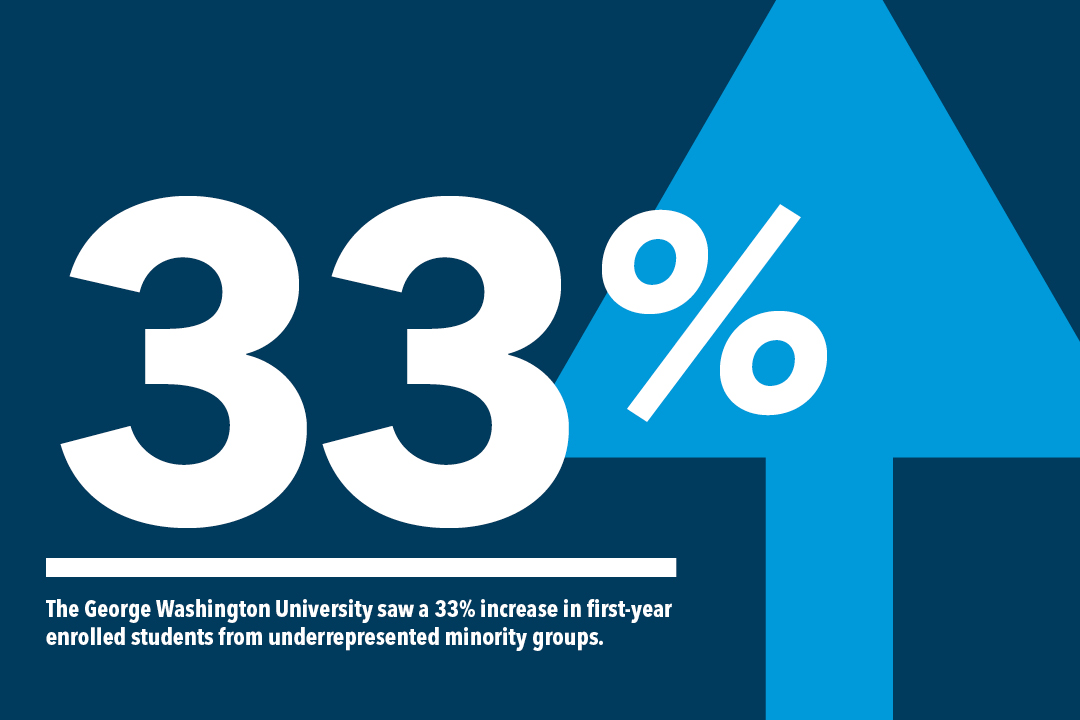The decision not to require SAT or ACT scores for most students applying for admission at the George Washington University has led to the most diverse freshmen class in the university’s history.
Among students who entered as freshmen in fall 2016, the university saw a 33 percent increase in students from underrepresented minority groups. This population makes up 20.2 percent of this year’s freshman class, compared with 14.9 percent of last year’s freshmen.
“We adopted our test-optional policy to diversify an already outstanding applicant pool by reaching out to exceptional students who have been underrepresented at selective colleges and universities,” said George Washington President Steven Knapp. “Our experience this first year under the new policy would seem to validate that approach.”
More than 25,550 undergraduate students applied to enter GW in fall 2016, an unprecedented 29 percent increase in applications over the previous year. Of the applicants, 21 percent opted to take advantage of GW’s test optional policy.
GW accepted 40 percent of applicants and enrolled a freshmen class of 2,523 students from 48 states, the District of Columbia and 60 countries. Of the total enrolled class, 29 percent chose not to submit test scores.
One element that influenced GW’s decision to adopt a test-optional admissions policy was a concern that outstanding, academically talented students who did not earn high scores on the SAT or ACT may have felt discouraged from applying. At the same time, studies have indicated that a sustained commitment to a rigorous course of study and exceptional performance in high school academic course work are the best indicators of how a student will fare in college.
In this first-year class after the test-optional policy, there are 84 percent more African-American freshmen over the previous year’s class, with 8.8 percent representation compared to 4.7 percent last year.
Other minority groups saw population increases as well. Hispanic student enrollment rose by 11 percent (10.5 percent of the class versus 9.2 percent last year).
In other diversity barometers, the number of students who identified as first-generation college students increased by 14 percent, with 13.9 percent of students identifying that neither of their parents had earned a bachelor’s degree compared to 11.9 percent the previous fall.
Finally, while financial aid numbers are still preliminary, it appears that the number of full-time freshmen students receiving Pell Grants increased to nearly 15 percent from 13.8 percent the previous year.
This year’s freshmen class also continues the four-year trend of an increase in the median unweighted academic GPA, which rose to 3.66 from 3.64 the previous year.
“The high GPA from our students is a sign that GW is continuing its momentum to strengthen the quality of the class and recruit the most academically strong and diverse students,” said Laurie Koehler, vice provost for enrollment management and retention. “We are excited to have enrolled such a talented group of students who feel that GW is a great fit for them.”
A Focus on Access and Success
The university’s test-optional policy was the first of many initiatives the university has undertaken in the past year to improve access to a college education for top students from all backgrounds.
In September 2015, GW joined with the nonprofit organization Say Yes to Education to provide full-tuition scholarships for public high school students from participating chapters in New York and North Carolina whose annual family income is at or below $75,000. In October 2015, the university announced a partnership with The Posse Foundation, a nationwide college access and youth leadership development program, to offer full-tuition leadership scholarships to select Atlanta-area public high school graduates. In December 2015, GW launched the District Scholars Award, a grant that will expand college access to District of Columbia high school students to ensure that high-achieving D.C. students from families with annual household incomes at or below $75,000 can attend GW when offered admission.
These initiatives are an outgrowth of the university’s Task Force on Access and Success, formed in January 2014 following Dr. Knapp’s participation in the White House summit on college opportunity.
The university’s other college access initiatives include the Gil and Jacki Cisneros Institute, which offers a pre-college program to high school juniors who are committed to leadership and service within the Hispanic community and the Native American Political Leadership Program INSPIRE, offering a pre-college program to Native American, Native Alaskan and Native Hawaiian high school students.
While the university has been committed to be accessible to students, it is also focusing on ensuring their success. This year, the university created a retention office dedicated to bringing academic and administrative units together to strengthen the likelihood that students will have a positive experience and graduate from GW. In collaboration with partners across campus, the office will be assessing institutional progress in the coming months and years.
“Now that we are enrolling more diverse and academically talented students, our next steps are to make sure that these students find success at GW and beyond,” said Ms. Koehler.


